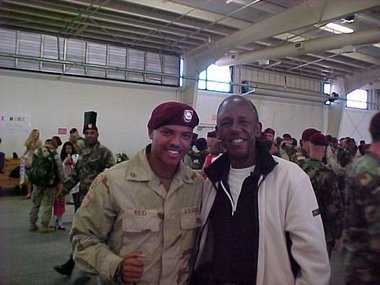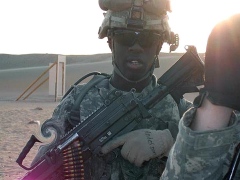With the latest advances in brain trauma care, hope for patients likes Representative Gabrielle Giffords is on the rise.
Read more: http://www.time.com/time/video/player/0,32068,749026237001_2042577,00.html#ixzz1ptrNDR64
New Hope for Brain Trauma Victims
Medical Schools to Increase Focus on PTSD, TBI

WASHINGTON — Medical schools will soon include more course work on post-traumatic stress disorder, traumatic brain injury and other common military ailments as part of a White House-led effort to prepare future physicians for the next generation of veteran patients.
First Lady Michelle Obama and officials from the Association of American Medical Colleges will announce the plans Wednesday afternoon. The effort includes more shared research and clinical trials among 130 medical and osteopathic schools around the country, including Ivy League and other major collegiate research institutions.
Officials from the association on Tuesday told reporters the goal is to ensure that young medical professionals are familiar with the signature wounds of war, and able to more effectively treat the millions of veterans who will struggle with those issues for decades to come.
White House officials said more than half of Iraq and Afghanistan veterans receiving treatment for mental health issues rely not on Department of Veterans Affairs physicians, but instead on private medical practices.
For some students, that will likely mean standalone courses on topics like PTSD and TBI, as well as other common battlefield injuries.
The effort is part of the first lady’s Joining Forces campaign, designed to highlight the sacrifices and needs of troops, veterans and their families. Program officials said no federal money is being used for the college coordination efforts, but Defense Department and VA officials will assist with planning and information sharing.
loading
First lady tackling medical treatment for vets
First lady tackling medical treatment for vets
By Julie Pace
AP
WASHINGTON (AP) — Michelle Obama has gotten a new commitment from medical schools to boost training and research for the treatment of veterans with post-traumatic stress disorder and other mental health injuries.
The initiative is part of the first lady’s Joining Forces `campaign, which focuses on issues affecting veterans and their families.
Culture of Stress: Why are service members taking their lives at such an alarming rate?
Culture of Stress: Why are service members taking their lives at such an alarming rate?, 31 July 2011, Patriot-News Op-Ed
By: Mike Reid

Mike Reid, left, is shown with his father after returning from one of his deployments to Iraq. Reid grew up in the Harrisburg area and served in the Army for six years. He now lives in Georgia and works as a personal trainer
The most important thing to know about me is what I was doing during the years 2002 to 2008. In that time, I became “Army Strong” and spent nearly three of those years in Iraq.
It’s never made clear exactly what the Army slogan “Army Strong” means. I believe that I have the most accurate and truthful interpretation of what it stands for, and it has nothing to do with the commercials you see daily.
America’s service members feel the need to end their own lives at an alarming rate. It’s time we started talking about this, not to mention the increased amount of domestic violence and child abuse.
The armed forces suicide rate is double the national average. More American troops committed suicide in 2009 than died in combat in Afghanistan that same year: That is 381 suicides compared to 319 combat deaths. The statistic alone should make your stomach turn.
Those 381 suicides are spread among all four branches of the military — Army, Air Force, Marines and Navy — although 162 of them were Army soldiers. The military doesn’t count the suicides from Reservists or National Guard personnel, only active duty.
In 2010, the Army suicide number jumped up to 245, more than half of the 434 suicides militarywide. In 2011, just through the month of May, the number was already at 163 for the Army alone. The U.S. Department of Veteran Affairs says roughly 600 military and former military personnel take their own lives each year.
Now, try to stomach this one. For every suicide in the military, at least five more service members are hospitalized for attempting to kill themselves.
The question on almost everybody’s mind is, what is causing all of these American troops to do this?
FULL ARTICLE AT: http://blog.pennlive.com/editorials/print.html?entry=/2011/07/culture_of_stress_what_are_ser.html
Cost of Treating Veterans Will Rise Long Past Wars
Cost of Treating Veterans Will Rise Long Past Wars, 27 July 2010, NY Times
By: James Dao
WASHINGTON — Though the withdrawal of American military forces from Iraq and Afghanistan will save the nation billions of dollars a year, another cost of war is projected to continue rising for decades to come: caring for the veterans.
By one measure, the cost of health care and disability compensation for veterans from those conflicts and all previous American wars ranks among the largest for the federal government — less than the military, Social Security and health care programs including Medicare, but nearly the same as paying interest on the national debt, the Treasury Department says.
Ending the current wars will not lower those veterans costs; indeed, they will rise ever more steeply for decades to come as the population of veterans from Iraq and Afghanistan expands, ages and becomes more infirm. To date, more than 2.2 million troops have served in those wars.
Studies show that the peak years for government health care and disability compensation costs for veterans from past wars came 30 to 40 years after those wars ended. For Vietnam, that peak has not been reached.
In Washington, the partisan stalemate over cutting federal spending is now raising alarms among veterans groups and some lawmakers that the seemingly inexorable costs of veterans benefits will spur a backlash against those programs.
Even if cuts to veterans programs do not occur, the current mood of budgetary constraint seems likely to force the Department of Veterans Affairs to make do without the large spending increases it has received from Congress in the recent past.
That means efforts by veterans groups to expand existing health care programs, provide additional benefits to Vietnam veterans or institute new research into things liketraumatic brain injury or hearing loss will face difficult uphill battles, lawmakers and veterans advocates say.
“No one is thinking about the lifetime costs this country is responsible for,” said Senator Patty Murray, a Washington Democrat who is chairwoman of the Senate Veterans’ Affairs Committee. “I’m really worried.”
FULL ARTICLE AT: http://www.nytimes.com/2011/07/28/us/28veterans.html?_r=2
Mental Problems Of Soldiers’ Kids Tied To Wars
Mental Problems Of Soldiers’ Kids Tied To Wars, 4 July 2011, Reuters.com
By Alina Selyukh

U.S. Marines of Weapons Company, 1st Battalion, 3rd Marines are silhouetted against the sunset during a joint patrol with Afghan National Army (ANA) soldiers along Helmand river near the Camp Gorgak in Helmand province, southern Afghanistan, July 3, 2011. Credit: Reuters/Shamil Zhumatov
WASHINGTON — The longer U.S. soldiers were deployed in Iraq or Afghanistan, the more likely their children would be diagnosed with mental health problems, according to a study published Monday.
The study, published in the Archives of Pediatrics and Adolescent Medicine, analyzed medical records of 307,520 children of active-duty Army personnel, aged 5 to 17 years old. It found almost 17 percent of them exhibited mental health problems.
“Children of parents who spent more time deployed between 2003 and 2006 fared worse than children whose parents were deployed for a shorter duration,” the study’s researchers wrote.
The lead researcher was Alyssa Mansfield, who was at the University of North Carolina at Chapel Hill at the time the study was conducted.
The U.S. Army reported some 562,000 members in active duty and more than 570,000 children of such members in 2010. Just under two-thirds of all active-duty servicemen and women were married and 15 percent were raising children as single parents.
FULL ARTICLE AT: http://www.reuters.com/article/2011/07/04/us-military-idUSTRE7634XD20110704
Maltreated And Hazed, One Soldier Is Driven To Take His Own Life
Maltreated And Hazed, One Soldier Is Driven To Take His Own Life, 7 June 2011, Stars and Stripes
By Megan McCloskey
Alarmed by rising suicides in their ranks, U.S. Army officials have launched multiple studies and directives to address the problem. But a Stars and Stripes investigation reveals two recent cases in which that high-level concern was thwarted by failures of leadership on the ground — and two more soldier suicides were added to the grim roster.
For Army Spc. Brushaun Anderson, there was no escaping his torment.
The senior noncommissioned officers who ruled his life at a remote patrol base in Iraq ordered him to wear a plastic trash bag because they said he was “dirty.”
They forced him to perform excessive physical exercises in his body armor over and over again.
They made him build a sandbag wall that served no military purpose.
Anderson seemed to take it all in stride. Until New Year’s Day 2010, when the once-eager 20-year-old soldier locked himself inside a portable toilet, picked up his M4 rifle, aimed the barrel at his forehead and pulled the trigger.
Anderson left behind a note lamenting his failures in the military, and some soldiers in his unit immediately said that Anderson had been driven to kill himself by leaders bent on humiliating him.
“No matter what Spc. Anderson did, no matter how big or small the incident was, his punishment was always extremely harsh, [and] a lot of the time demeaning,” one corporal later told Army investigators.
“Spc. Anderson’s punishments were not like anyone else’s in the platoon,” another corporal said. “Spc. Anderson was singled out.”
The U.S. Army is confronting an unprecedented suicide crisis. Since the start of the wars in Afghanistan and Iraq, more than 1,100 soldiers have taken their own lives, with the numbers escalating each year for the last six years. Last year alone, 301 soldiers committed suicide — a new record.
FULL ARTICLE AT: http://www.stripes.com/news/special-reports/suicide-in-the-military/maltreated-and-hazed-one-soldier-is-driven-to-take-his-own-life-1.145941#
The Cost Of War
The Cost Of War, 11 April 2011, Houston Chronicle
Clay Hunt was “a war hero and giant-hearted humanitarian,” read his obituary, detailing his tours of duty in Iraq and Afghanistan, and his volunteer work in earthquake-stricken Haiti and Chile. As a Marine, “he often wondered why he survived when so many close friends and others paid the ultimate price for our nation’s freedom.”
The sad truth is that he didn’t survive. He returned from those wars with post-traumatic stress disorder and could never shake the survivor’s guilt at his comrades’ deaths. Finally, on March 31 of this year, he committed suicide in his Houston apartment, far from combat zones, but just as surely another battlefield casualty.
As reported by the Chronicle’s Lindsay Wise, Hunt, who had been active in suicide prevention efforts, had a hard time adjusting to civilian life after his discharge in 2009. He dropped out of college, divorced and had suicidal thoughts.
Things were looking up in recent months. He moved back to Houston, found a job and received medication for his depression and PTSD. But that didn’t save him.
Records are kept of suicides within the military: Last year, 468 military suicides were reported. But it’s impossible to say how many commit suicide after they leave the armed forces, since no statistics are kept unless a vet is treated by the Veterans Affairs agency.
FULL ARTICLE AT: http://www.chron.com/disp/story.mpl/editorial/7516062.html
Female Soldiers’ Suicide Rate Triples When At War
Female Soldiers’ Suicide Rate Triples When At War, 18 March 2011 , USA Today
By Gregg Zoroya
The suicide rate for female soldiers triples when they go to war, according to the first round of preliminary data from an Army study.
The findings, released to USA TODAY this week, show that the suicide rate rises from five per 100,000 to 15 per 100,000 among female soldiers at war. Scientists are not sure why but say they will look into whether women feel isolated in a male-dominated war zone or suffer greater anxieties about leaving behind children and other loved ones.
Even so, the suicide risk for female soldiers in Iraq or Afghanistan is still lower than for men serving next to them, the $50 million study says.
Findings also show that marriage somehow helps inoculate male and female soldiers from killing themselves while they are overseas. Although these death rates among GI’s who are single or divorced double when they go to war, the rate among married soldiers does not increase, according to the study.
FULL ARTICLE AT: http://www.usatoday.com/news/military/2011-03-18-1Asuicides18_ST_N.htm
Lawsuit Says Military Is Rife With Sexual Abuse
Lawsuit Says Military Is Rife With Sexual Abuse, 16 Feb 2011, New York Times
By Ashley Parker

Kori Cioca, in her lawyer's office on Sunday, described being raped while serving in the Coast Guard. She is one of 17 plaintiffs filing a federal lawsuit against the Department of Defense.
WASHINGTON — A federal lawsuit filed Tuesday accuses the Department of Defense of allowing a military culture that fails to prevent rape and sexual assault, and of mishandling cases that were brought to its attention, thus violating the plaintiffs’ constitutional rights.
The suit — brought by 2 men and 15 women, both veterans and active-duty service members — specifically claims that Defense Secretary Robert M. Gates and his predecessor, Donald H. Rumsfeld, “ran institutions in which perpetrators were promoted and where military personnel openly mocked and flouted the modest Congressionally mandated institutional reforms.”
It also says the two defense secretaries failed “to take reasonable steps to prevent plaintiffs from being repeatedly raped, sexually assaulted and sexually harassed by federal military personnel.”
Myla Haider, a former Army sergeant and a plaintiff in the suit, said she was raped in 2002 while interning in Korea with the military’s Criminal Investigative Command. “It is an atmosphere of zero accountability in leadership, period,” she said an interview.
Ms. Haider, who appeared with other plaintiffs at a news conference earlier Tuesday at the National Press Club, said: “The policies that are put in place are extremely ineffectual. There was severe maltreatment in these cases, and there was no accountability whatsoever. And soldiers in general who make any type of complaint in the military are subject to retaliation and have no means of defending themselves.”
In the complaint, Ms. Haider said she did not report her rape because she “did not believe she would be able to obtain justice.” But she said she joined the suit because she wanted to “address the systematic punishment of soldiers who come forward with any type of complaint,” whether it involves sexual assault or post-traumatic stress disorder related to combat.
FULL ARTICLE AT: http://www.nytimes.com/2011/02/16/us/16military.html








